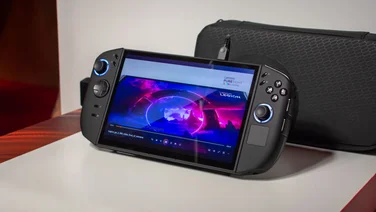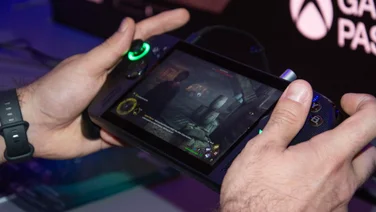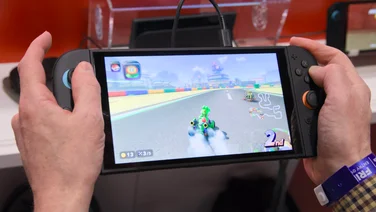To help us provide you with free impartial advice, we may earn a commission if you buy through links on our site. Learn more

Tired of squinting at the teeny screen on your Nintendo Switch? You might want to take a look at the Lenovo Legion Go, which has just been unveiled at IFA 2023, the annual technology show held in Berlin.
It’s a direct rival to handheld gaming portables such as the Steam Deck and the Asus ROG Ally. Like the Ally, it runs Windows 11, so there’s a huge selection of games you can play on it, from casual stuff like Vampire Survivors to big-name AAA titles like Diablo IV.
READ NEXT: The best handheld gaming consoles

Lenovo Legion Go hands-on: Specifications, release date and price
- 8.8in QHD+ (2,560 x 1,600), 16:10, 144Hz IPS LCD display
- AMD Ryzen 1 Extreme APU with Radeon 700M series graphics
- 16GB of RAM
- Up to 1TB SSD
- Up to 2TB microSD card support
- 49Wh battery
- 2x USB-C 4 with Thunderbolt 3 and DisplayPort 1.4 support
- Wi-Fi 6E and Bluetooth 5.2
- Dimensions with controllers: 210 x 20 x 131mm (WDH)
- Weight with controllers: 854g
- Price: £699
- Availability: October 2023
Lenovo Legion Go hands-on: Design, key features and first impressions
The Lenovo Legion Go is a chunky thing but it isn’t as heavy as it looks. It doesn’t feel quite as well made as the ROG Ally – the plastics have a thinner, more hollow feel to them – but neither does it feel fragile or particularly flimsy.Looks wise, though, it sits closer to the Steam Deck than the Ally with its large grips, black finish and the single, small touchpad set into the right controller.
And those controllers are fully featured affairs. In the short time I had to try the Legion Go out in a hotel room before the conference started, I found them reasonably comfortable – probably due to their large size and the sculpted grips – with all the controls falling nicely under finger and thumb. As you’d expect, there are two clickable analogue thumbsticks set into the face of the controllers, the right one set slightly lower than the left.

A set of ABXY buttons is on the right controller and a four-way clickable D-Pad on the left, and each controller has shoulder bumper buttons, analogue triggers plus a whole selection of customisable buttons set into the rear of the grip. This is topped off with a selection of menu and settings buttons and a tiny touchpad on the right hand grip, while the volume and power buttons are lined up along the top edge of the device.
The controllers can be detached, just like on the Nintendo Switch, and there’s a full width kickstand at the rear so you can prop up the screen on a table, which is useful if your wrists get tired holding the whole console in your hands. Alternatively, you can use one of the console’s two USB 4 ports to hook up the Legion Go to an external monitor or TV.
Lenovo is also planning to sell a clever accessory for the Legion Go that turns the right controller into a wireless mouse. It looks a little weird but if you pop the controller into the ring (it attaches magnetically) it should make Windows 11 a little easier to navigate. With such an awkward shape, however, I can’t imagine I would ever be comfortable using it for gaming.

The display is the star of the show here, though. It’s 1.8in larger than both the Ally and the Steam Deck’s displays and higher in resolution, bright at 500nits, and the 144Hz refresh rate ensures smooth motion, too.
More pixels aren’t always a great idea when it comes to gaming, as it puts more strain on graphics hardware, but I can report that the screen looked great when I tried it out with a couple of, admittedly rather lightweight, titles prior to the launch.

Other specifications are promising, too. As mentioned above, there are two USB 4 ports on the device – one at the top and one at the bottom. Both support up to 40Gbits/sec data transfers, DisplayPort 1.4 and USB charging as well. There’s also support for Wi-Fi 6E and Bluetooth 5.2 and it’s nice to see a microSD card slot for storage expansion here. You can add up to 2TB to the internal storage, which can be specified at up to 1TB.
As with the ROG Ally, Lenovo will have its own game launcher software running on the console but this wasn’t running on the device I tried, unfortunately.
READ NEXT: Nintendo Switch OLED review
Lenovo Legion Go hands-on: Early verdict
I like the look of the Lenovo Legion Go, especially its large display and button-festooned detachable controllers. The wireless mouse capability sounds intriguing, too, but if I wanted to play FPS games on the go, I’d probably just bring along a lightweight gaming mouse.
It probably won’t replace the Nintendo Switch in many gamers’ collections, purely because of the price. That’s been set by Lenovo at £699, although the good news is that’s the same as the Asus ROG Ally, which comes with a smaller 1080p display.
And if you fancy picking one up, you won’t have long to wait, either. The Lenovo Legion Go will be available to buy in October 2023. We’ll update you with a full review as and when we get our hands on a review sample.







